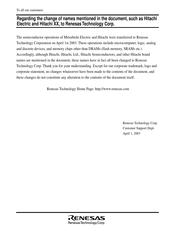User Manuals: Hitachi HD6433061B Computer Hardware
Manuals and User Guides for Hitachi HD6433061B Computer Hardware. We have 1 Hitachi HD6433061B Computer Hardware manual available for free PDF download: Hardware Manual
Hitachi HD6433061B Hardware Manual (995 pages)
Single-Chip Microcomputer H8/3062 Series; H8/3062B Series; H8/3062F-ZTAT series; H8/3064F-ZTAT series
Brand: Hitachi
|
Category: Computer Hardware
|
Size: 4.08 MB
Table of Contents
-
-
Overview49
-
-
Tables
50 -
-
Overview77
-
Data Formats84
-
-
-
Overview107
-
Reset State110
-
Power-Down State111
-
-
-
Overview111
-
-
-
-
Overview115
-
-
Reserved Areas123
-
-
-
Overview133
-
Reset136
-
Interrupts140
-
Trap Instruction140
-
-
-
Overview145
-
-
Usage Notes168
-
-
-
Overview171
-
-
Operation185
-
Area Division185
-
-
-
Overview193
-
Valid Strobes194
-
Memory Areas195
-
Wait Control203
-
-
Idle Cycle205
-
Bus Arbiter207
-
-
-
-
Overview269
-
Features269
-
Block Diagrams271
-
-
-
CPU Interface296
-
Operation299
-
Overview299
-
Basic Functions299
-
Synchronization307
-
PWM Mode309
-
-
Interrupts316
-
Usage Notes320
-
-
8-Bit Timers
333-
Overview333
-
-
CPU Interface349
-
8-Bit Registers349
-
-
Operation351
-
Interrupt359
-
Usage Notes361
-
-
-
Overview371
-
Features371
-
Block Diagram372
-
-
-
Operation387
-
Overview387
-
Output Timing388
-
-
Usage Notes394
-
-
-
Overview397
-
Features397
-
Block Diagram398
-
-
-
Operation405
-
Interrupts408
-
Usage Notes408
-
-
-
Overview409
-
Features409
-
Block Diagram411
-
-
-
Operation436
-
Overview436
-
-
SCI Interrupts463
-
Usage Notes464
-
-
-
Overview469
-
Operation477
-
Overview477
-
Pin Connections477
-
Data Format478
-
Clock482
-
-
Usage Notes491
-
-
-
Overview495
-
CPU Interface502
-
Operation504
-
Interrupts510
-
Usage Notes510
-
-
-
Section 16 RAM
523 -
Section 17 ROM
527 -
-
-
Erase Mode656
-
-
-
Overview675
-
-
Prescalers680
-
-
-
Overview683
-
Sleep Mode690
-
-
Usage Note693
-
-
-
-
-
-
-
-
-
-
Clock Timing801
-
Bus Timing804
-
-
-
Instruction List811
-
-
-
Address List839
-
Address List849
-
Address List859
-
Functions869
-
B.4 Functions869
-
Flash Memory889
-
-
-
-
Advertisement
Advertisement
